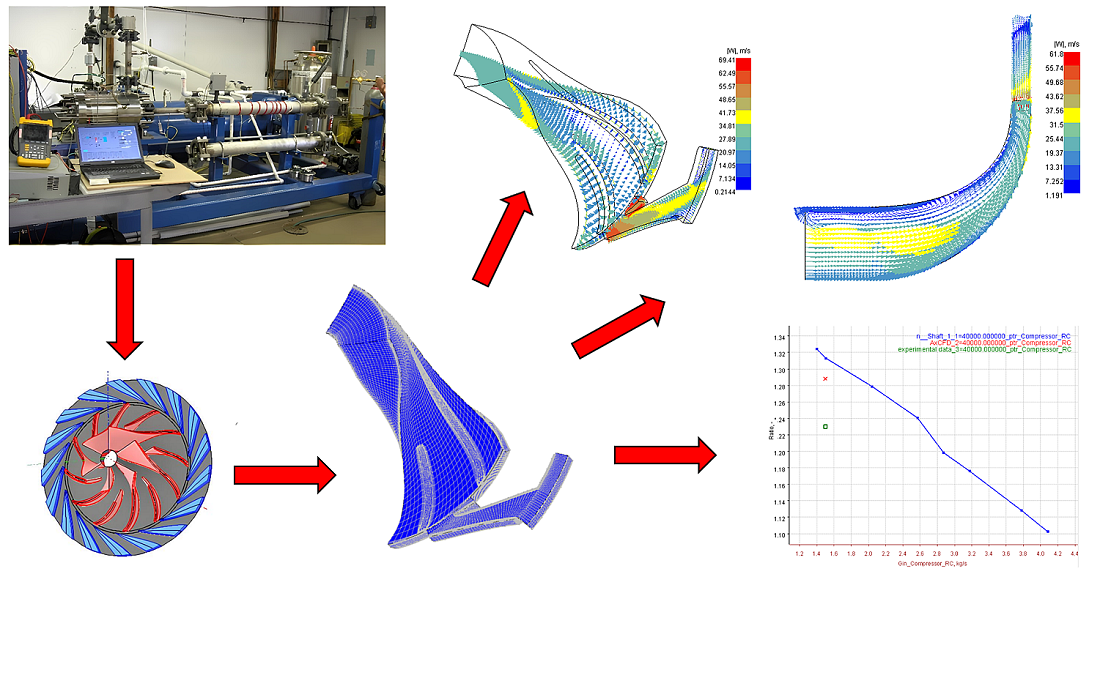Виявлення впливу використання модифікованого рівняння стану редліха-квонга-анг’є на розрахунок течії рідкого діоксиду вуглецю в відцентровому компресорі
DOI:
https://doi.org/10.15587/1729-4061.2024.302837Ключові слова:
відцентровий компресор, область чистої рідини CO2, модифіковане рівняння стану Редліха-Квонга-Анг’є, тиск рідиниАнотація
Надкритичні цикли СО2 (S-CO2) знайшли застосування в енергетиці і можуть досягати високої ефективності у широкому діапазоні температур і тисків. Рівняння стану реального газу Редліха-Квонга-Анг’є використовується для опису термодинамічних параметрів робочої рідини СО2. Найбільшою проблемою при його використанні є моделювання фазового переходу між різними станами та областю критичної точки робочої рідини.
Об’єктом дослідження є робочий процес в відцентровому компресорі, розташованому в контурі стиснення з робочою рідиною CO2. Запропонована математична модель модифікованого рівнянні стану Редліха-Квонга-Анг’є дозволяє виконувати фазовий перехід першого роду з рідкої до надкритичної області навіть поблизу критичної точки. В модифіковане рівняння стану додано масштабну поправку, що дозволило значно зменшити похибку у визначенні тиску в широкому діапазоні температур порівняно із вихідним рівнянням стану. Запропонована математична модель може застосовуватись в області чистої рідини, обмеженої діапазоном температур від 220 K до 300 К.
Математична модель використана для вирішення аеродинамічної задачі у 3D просторі, зокрема для визначення термодинамічних та кінематичних властивостей потоку у відцентровому компресорі в широкому діапазоні режимів роботи. Проведено співставлення результатів дослідження з експериментом зі звіту Sandia National Laboratories (США). Отримано задовільний збіг результатів у робочій точці характеристики компресора (менше 5 % розбіжності).
Завдяки простоті форми рівняння стану та невеликій кількості (сім) емпіричних коефіцієнтів, отримана математична модель може використовуватися для практичних задач обчислювальної гідродинаміки без значних витрат обчислювального часу
Посилання
- Dostal, V., Driscoll, M. J., Hejzlar, P. (2004). A Supercritical Carbon Dioxide Cycle for Next Generation Nuclear Reactors. MIT-ANT-TR-100. Available at: https://web.mit.edu/22.33/www/dostal.pdf
- Wright, S., Conboy, T., Radel, R., Rochau, G. (2011). Modeling and experimental results for condensing supercritical CO2 power cycles. Office of Scientific and Technical Information (OSTI). https://doi.org/10.2172/1030354
- Yu, B., Yang, J., Wang, D., Shi, J., Chen, J. (2019). An updated review of recent advances on modified technologies in transcritical CO2 refrigeration cycle. Energy, 189, 116147. https://doi.org/10.1016/j.energy.2019.116147
- Allison, T. C., McClung, A. (2019). Limiting Inlet Conditions for Phase Change Avoidance in Supercritical CO2 Compressors. Volume 9: Oil and Gas Applications; Supercritical CO2 Power Cycles; Wind Energy. https://doi.org/10.1115/gt2019-90409
- Brinckman, K. W., Hosangadi, A., Liu, Z., Weathers, T. (2019). Numerical Simulation of Non-Equilibrium Condensation in Supercritical CO2 Compressors. Volume 9: Oil and Gas Applications; Supercritical CO2 Power Cycles; Wind Energy. https://doi.org/10.1115/gt2019-90497
- Mortzheim, J., Hofer, D., Priebe, S., McClung, A., Moore, J. J., Cich, S. (2021). Challenges With Measuring Supercritical CO2 Compressor Performance When Approaching the Liquid-Vapor Dome. Volume 10: Supercritical CO2. https://doi.org/10.1115/gt2021-59527
- Redlich, Otto., Kwong, J. N. S. (1949). On the Thermodynamics of Solutions. V. An Equation of State. Fugacities of Gaseous Solutions. Chemical Reviews, 44 (1), 233–244. https://doi.org/10.1021/cr60137a013
- Karaefe, R. E., Post, P., Sembritzky, M., Schramm, A., di Mare, F., Kunick, M., Gampe, U. (2020). Numerical Investigation of a Centrifugal Compressor for Supercritical CO2 Cycles. Volume 11: Structures and Dynamics: Structural Mechanics, Vibration, and Damping; Supercritical CO2. https://doi.org/10.1115/gt2020-15194
- Krishna, A. B., Jin, K., Ayyaswamy, P. S., Catton, I., Fisher, T. S. (2022). Modeling of Supercritical CO2 Shell-and-Tube Heat Exchangers Under Extreme Conditions. Part I: Correlation Development. Journal of Heat Transfer, 144 (5). https://doi.org/10.1115/1.4053510
- Zheng, S., Wei, M., Song, P., Hu, C., Tian, R. (2020). Thermodynamics and flow unsteadiness analysis of trans-critical CO2 in a scroll compressor for mobile heat pump air-conditioning system. Applied Thermal Engineering, 175, 115368. https://doi.org/10.1016/j.applthermaleng.2020.115368
- Soave, G. (1972). Equilibrium constants from a modified Redlich-Kwong equation of state. Chemical Engineering Science, 27 (6), 1197–1203. https://doi.org/10.1016/0009-2509(72)80096-4
- Peng, D.-Y., Robinson, D. B. (1976). A New Two-Constant Equation of State. Industrial & Engineering Chemistry Fundamentals, 15 (1), 59–64. https://doi.org/10.1021/i160057a011
- Vorobieva, H. S. (2021). Modification of the Redlich-Kwong-Aungier Equation of State to Determine the Degree of Dryness in the CO2 Two-phase Region. Journal of Mechanical Engineering, 24 (4), 17–27. https://doi.org/10.15407/pmach2021.04.017
- Aungier, R. H. (1995). A Fast, Accurate Real Gas Equation of State for Fluid Dynamic Analysis Applications. Journal of Fluids Engineering, 117 (2), 277–281. https://doi.org/10.1115/1.2817141
- SoftInWay. Available at: https://www.softinway.com/
- Wright, S., Radel, R., Vernon, M., Pickard, P., Rochau, G. (2010). Operation and analysis of a supercritical CO2 Brayton cycle. Office of Scientific and Technical Information (OSTI). https://doi.org/10.2172/984129
- The National Institute of Standards and Technology (NIST). Available at: https://www.nist.gov/
- Kislov, O., Ambrozhevich, M., Shevchenko, M. (2021). Development of a method to improve the calculation accuracy of specific fuel consumption for performance modeling of air-breathing engines. Eastern-European Journal of Enterprise Technologies, 2 (8 (110)), 23–30. https://doi.org/10.15587/1729-4061.2021.229515

##submission.downloads##
Опубліковано
Як цитувати
Номер
Розділ
Ліцензія
Авторське право (c) 2024 Hanna Vorobiova, Dmytro Dolmatov, Iurii Sysoiev, Oleh Dehtiarov , Maryna Ivashchenko, Kseniia Fesenko

Ця робота ліцензується відповідно до Creative Commons Attribution 4.0 International License.
Закріплення та умови передачі авторських прав (ідентифікація авторства) здійснюється у Ліцензійному договорі. Зокрема, автори залишають за собою право на авторство свого рукопису та передають журналу право першої публікації цієї роботи на умовах ліцензії Creative Commons CC BY. При цьому вони мають право укладати самостійно додаткові угоди, що стосуються неексклюзивного поширення роботи у тому вигляді, в якому вона була опублікована цим журналом, але за умови збереження посилання на першу публікацію статті в цьому журналі.
Ліцензійний договір – це документ, в якому автор гарантує, що володіє усіма авторськими правами на твір (рукопис, статтю, тощо).
Автори, підписуючи Ліцензійний договір з ПП «ТЕХНОЛОГІЧНИЙ ЦЕНТР», мають усі права на подальше використання свого твору за умови посилання на наше видання, в якому твір опублікований. Відповідно до умов Ліцензійного договору, Видавець ПП «ТЕХНОЛОГІЧНИЙ ЦЕНТР» не забирає ваші авторські права та отримує від авторів дозвіл на використання та розповсюдження публікації через світові наукові ресурси (власні електронні ресурси, наукометричні бази даних, репозитарії, бібліотеки тощо).
За відсутності підписаного Ліцензійного договору або за відсутністю вказаних в цьому договорі ідентифікаторів, що дають змогу ідентифікувати особу автора, редакція не має права працювати з рукописом.
Важливо пам’ятати, що існує і інший тип угоди між авторами та видавцями – коли авторські права передаються від авторів до видавця. В такому разі автори втрачають права власності на свій твір та не можуть його використовувати в будь-який спосіб.










